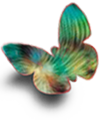Search
Title: Biomimetic Submicroarrayed Cross-Linked Liquid Crystal Polymer Films with Different Wettability via Colloidal Lithography
Author: Yuanyuan Zhan, Jianqiang Zhao, Wendong Liu, Bai Yang, Jia Wei, Yanlei Yu*
Journal: ACS Appl. Mater. Interfaces, 2015, 7(45), 25522–25528
Abstract:
Photoresponsive cross-linked liquid crystal polymer (CLCP) films with different surface topographies, submicropillar arrays, and submicrocone arrays were fabricated through colloidal lithography technique by modulating different types of etching masks. The prepared submicropillar arrays were uniform with an average pillar diameter of 250 nm and the cone bottom diameter of the submicrocone arrays was about 400 nm, which are much smaller than previously reported CLCP micropillars. More interestingly, these two species of films with the same chemical structure represented completely different wetting behavior of water adhesion and mimicked rose petal and lotus leaf, respectively. Both the submicropillar arrayed film and the submicrocone arrayed film exhibited superhyrophobicity with a water contact angle (CA) value of 144.0 ± 1.7° and 156.4 ± 1.2°, respectively. Meanwhile, the former demonstrated a very high sliding angle (SA) greater than 90°, and thus, the water droplet was pinned on the surface as rose petal. On the contrary, the SA of the submicrocone arrayed CLCP film consisting of micro- and nanostructure was only 3.1 ± 2.0°, which is as low as that of lotus leaf. Furthermore, the change on the wettability of the films was also investigated under alternating irradiation of visible light with two different wavelengths, blue light and green light.
Fulltext Link: https://pubs.acs.org/doi/10.1021/acsami.5b09013

The submicropillar arrayed CLCP film and the submicrocone arrayed CLCP film with different wettability due to the controllable surface topography were fabricated using colloidal lithography technique. The microarrayed pillar and cone are uniform with average diameters of sub-250 nm and sub-400 nm, respectively, which are much smaller than ever reported. Owing to the surface chemistry and surface morphology designed to obtain substantial hydrophobicity, the submicropillar arrayed film exhibited hydrophobicity with high water adhesion similar to the case of rose petal, while the submicrocone arrayed film possessing a hierarchical morphology showed the water repellent characteristic, which can be favorably compared to that of the lotus leaf. Reversible CAs switching in superhydrophobic region was observed in both microarrayed films when alternately irradiated by blue and green light. Moreover, the submicropillar arrayed film still demonstrated the high water adhesion after the blue light irradiation, while the photoinduced reversible SA change of the submicrocone arrayed film ranging between 3.1 ± 2.0° and 6.1 ± 2.2° was induced by alternating blue and green light irradiation. We believe that such a colloidal lithography method, in conjunction with CLCP, can be implemented to produce various types of surface topographies with further dynamic surface wettability just by regulating the etching masks throughout the fabrication process.







